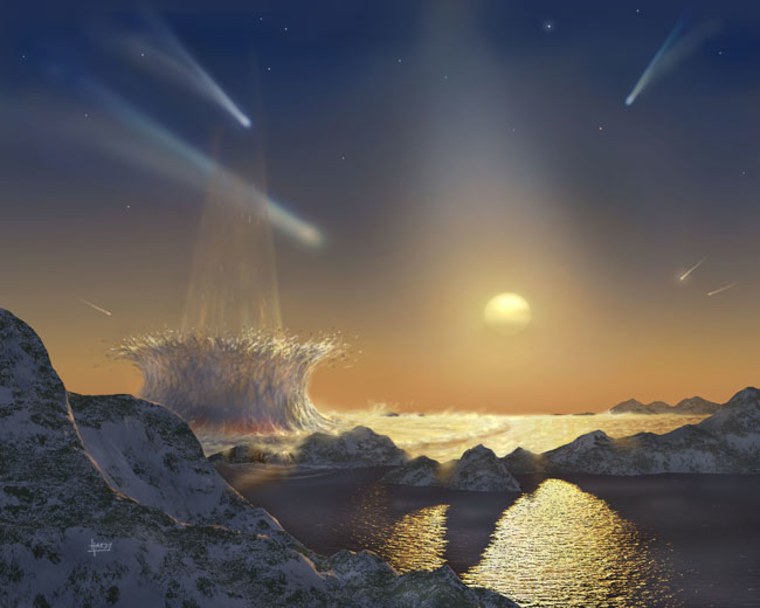Some stars have a high level of comet activity around them, and that could spell doom for any life trying to take root on any local planets. Ongoing research is trying to determine what fraction of stellar systems may be uninhabitable due to comet impacts.
Many of our own solar system's comets are found in the Kuiper Belt, a debris-filled disk that extends from Neptune's orbit (30 AU) out to almost twice that distance. Other stars have been shown to have similar debris disks.
"The debris is dust and larger fragments produced by the break-up of comets or asteroids as they collide amongst themselves," says Jane Greaves of the University of St. Andrews in Scotland.
Roughly 20 percent of nearby sun-like stars have debris disks that are more substantial than our Kuiper Belt, according to data from the Spitzer space telescope. More debris means more comets, but does this also mean more killer impacts for any Earth-like planets that might be orbiting these stars?
The answer depends on whether there are any gas giant planets around.
Jupiter is known to shield Earth from some comets by deflecting them out of the solar system. However, scientists showed in 2007 that Jupiter also injects other comets into Earth-crossing orbits. In fact, if Jupiter were Saturn's size, the number of impacts on Earth would have been much higher.
Greaves has been modeling how comets are generally affected by gas giants. Her early results indicate that comets will be a major problem around a few percent of sun-like stars.
Comet sweep
Early in our solar system's history, there were plenty of remnants left over from planet formation. All this debris led to a heavy bombardment of comets and asteroids on the inner planets, as evident in the crater record of the moon (on Earth, most of these scars have eroded away with time or have disappeared due to tectonic activity).
The number of impacts eventually tapered off around 3.8 billion years ago, 700 million years after the solar system formed.
The cause of this decrease may have been a shift in the orbits of the gas giants that cleared away many of the comets. Jupiter and Saturn appear to have migrated outwards, pushing out on the orbits of Uranus and Neptune. This in turn perturbed the Kuiper Belt and ejected many of the comets into interstellar space, Greaves says.
"This might be a very peculiar event, or it might happen in other star systems — we don't know yet, because we have limited information about their giant planets," she says.
Catastrophic impact
Still, our planet has not been completely immune to deadly impacts.
Many scientists believe the dinosaurs were snuffed out by a 4-20 kilometer-wide comet or asteroid that struck 65 million years ago at a point on the Yucatan peninsula. The impact led to a global firestorm and the eventual extinction of more than half of the planet's life forms.
Slideshow 12 photos
Month in Space: January 2014
A 100-kilometer impactor would have left no survivors. Such a "catastrophic impact" would destroy the entire crust of the Earth and eject the atmosphere into space.
The Earth likely experienced a few of these catastrophic impacts very early on, before life as we know it had even begun.
"While 'dinosaur-killer' class impacts occur about every 100 million years [on Earth], we would be unlikely to experience another 100-km class event in the lifetime of the sun," Greaves says.
How much higher would the impact rate on a planet need to be to prevent life from ever forming?
Greaves thinks that life could not evolve on a planet where 10-100 kilometer-size impactors hit every 20 million years. This kind of bombardment doesn't allow organisms enough time to recover between blows. The level of biodiversity remains low, so there's less probability that any species will survive the next devastating impact.
In previous work, Greaves and her colleagues speculated that Tau Ceti — a nearby sun-like star that has been a favorite target of SETI searches — is uninhabitable due to the large number of comets that appear to be buzzing around it (although this assessment may have been overly pessimistic, she now says).
Her team is currently looking at the general threat posed by comets. They have modeled various representative planetary systems (both with and without gas giants). From this, they estimate that at least a few percent of stars are going to be too comet-stricken to be in the running as possible hosts for life.

